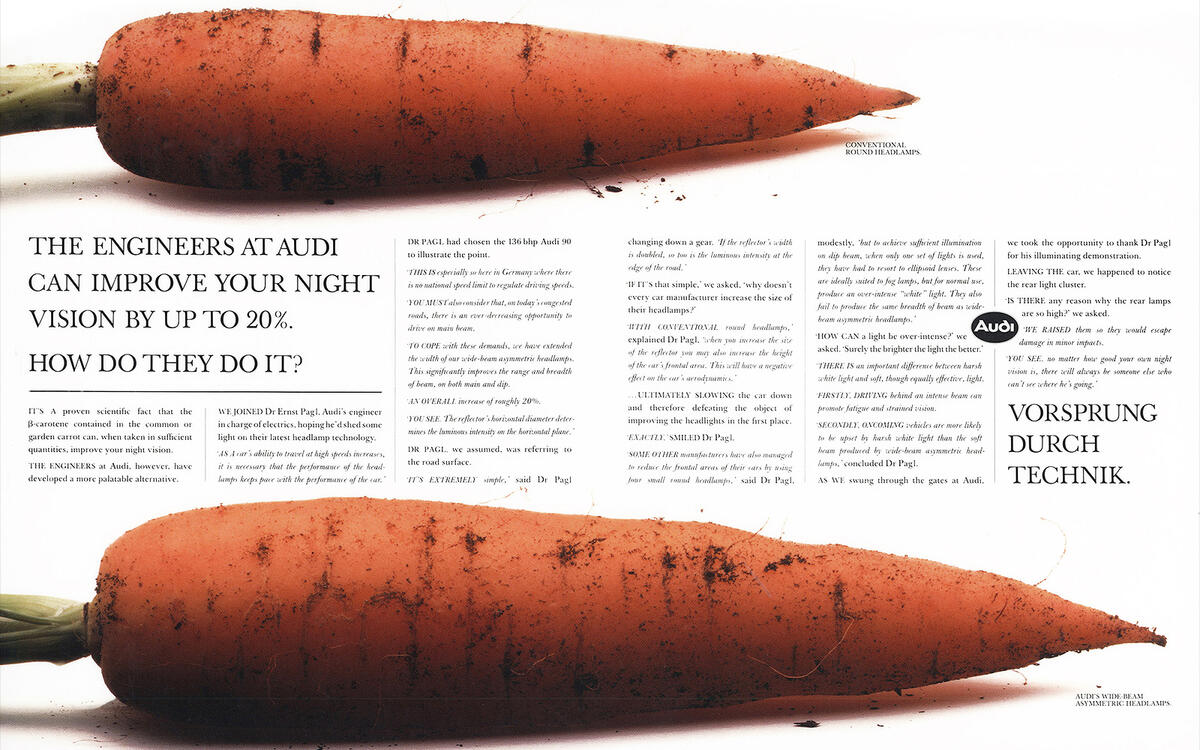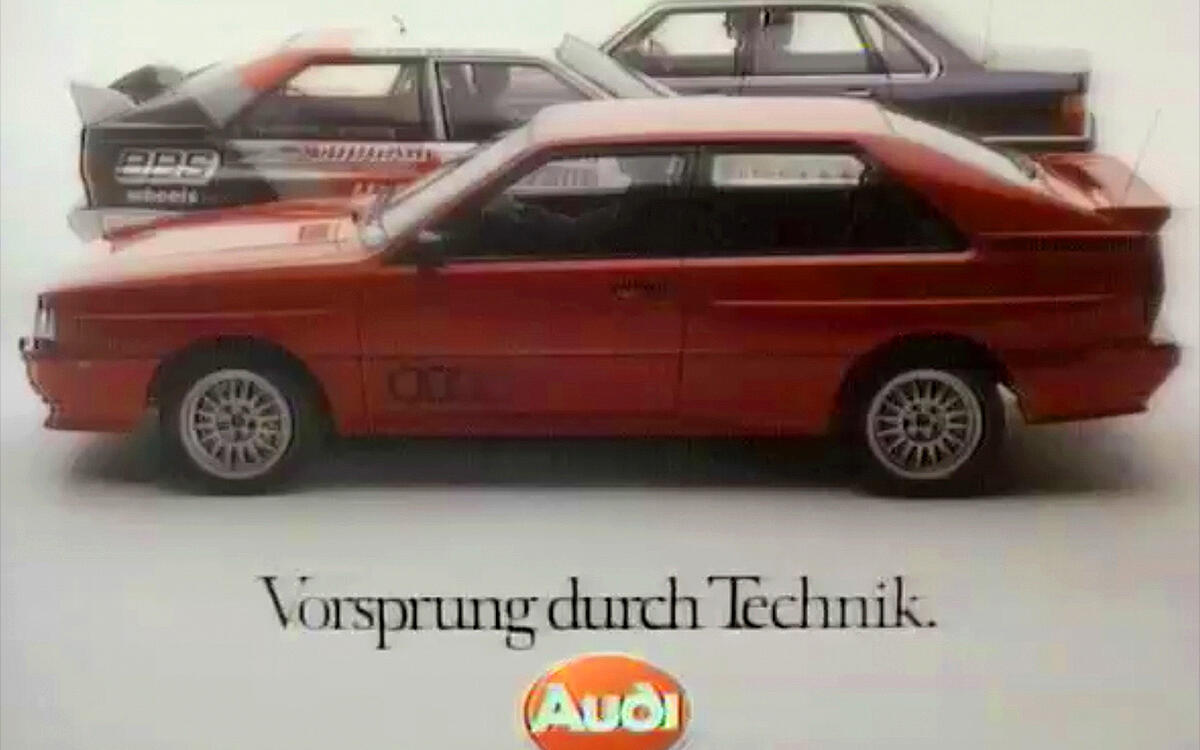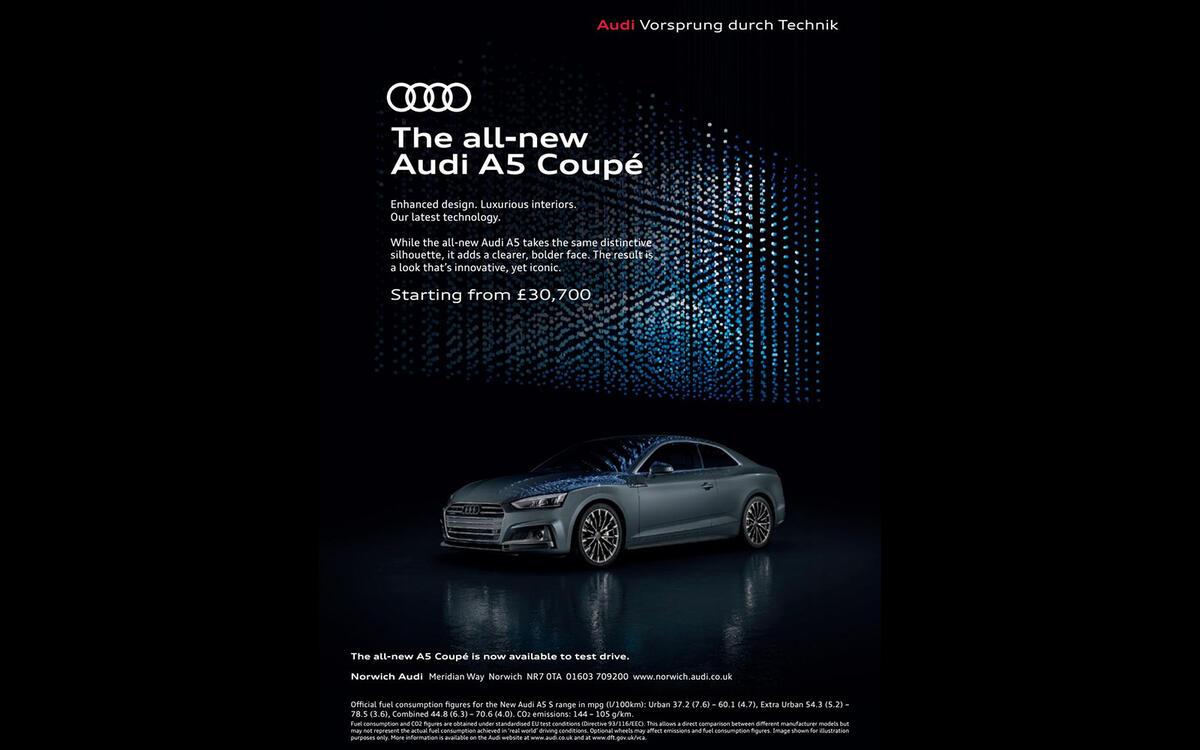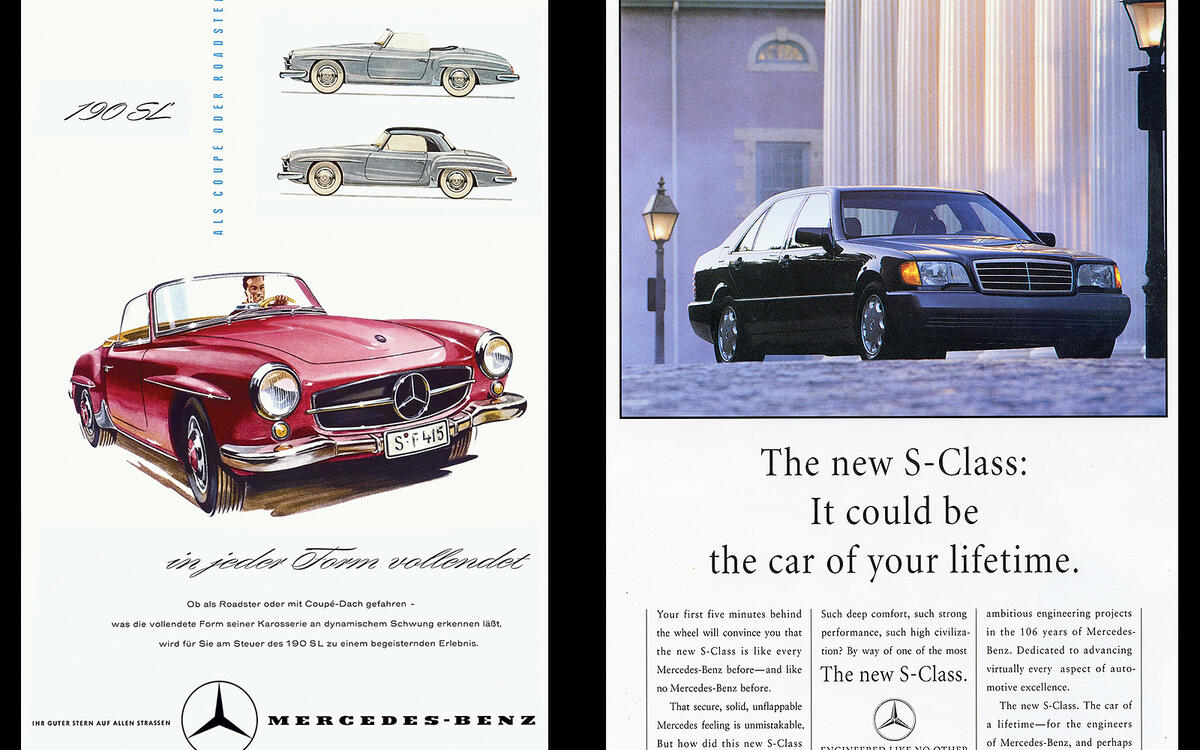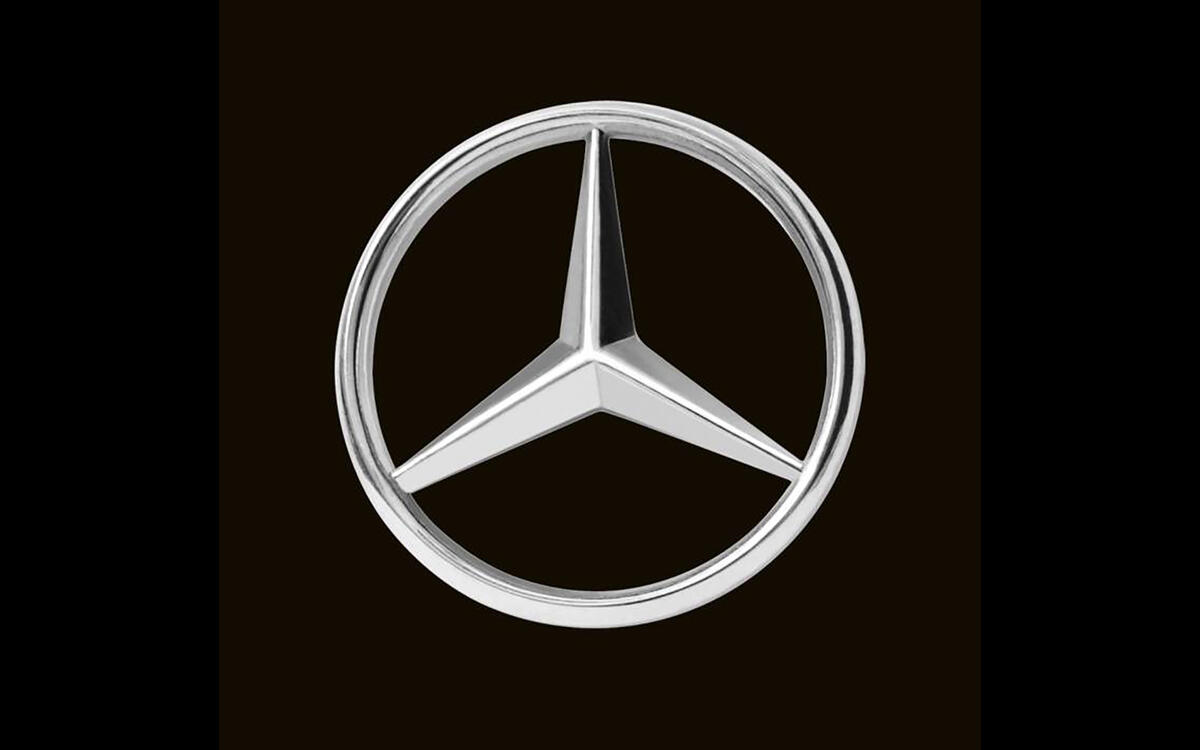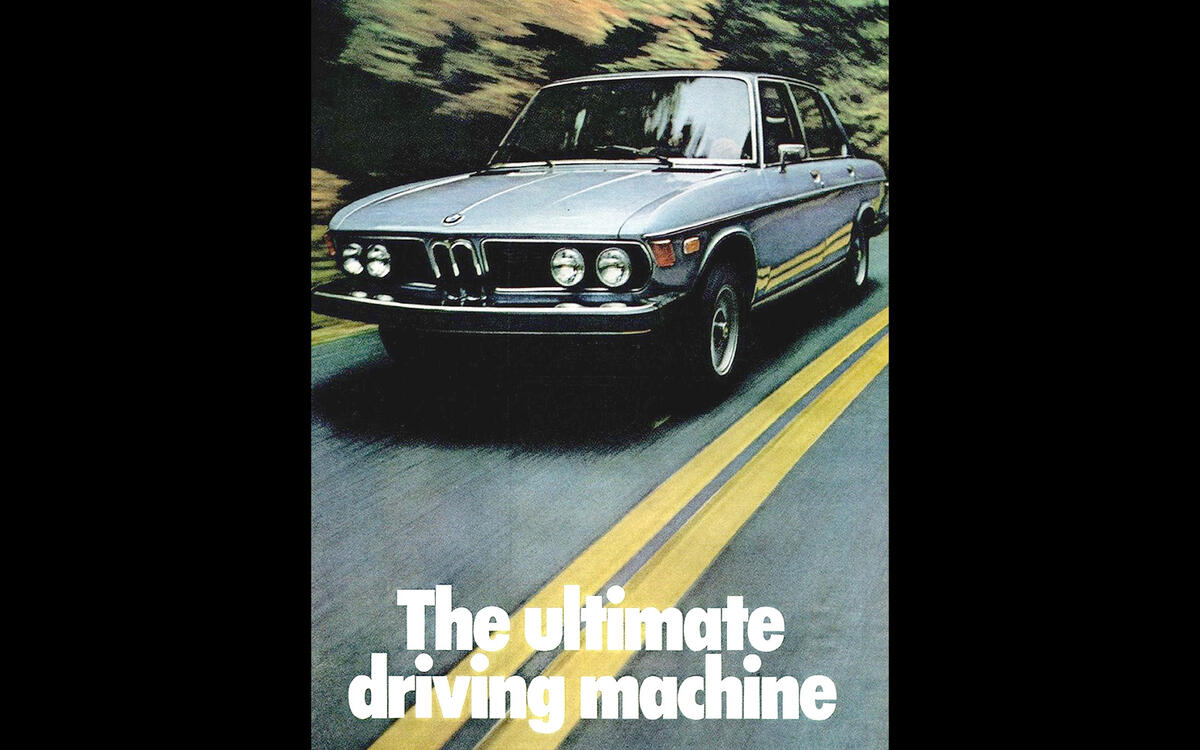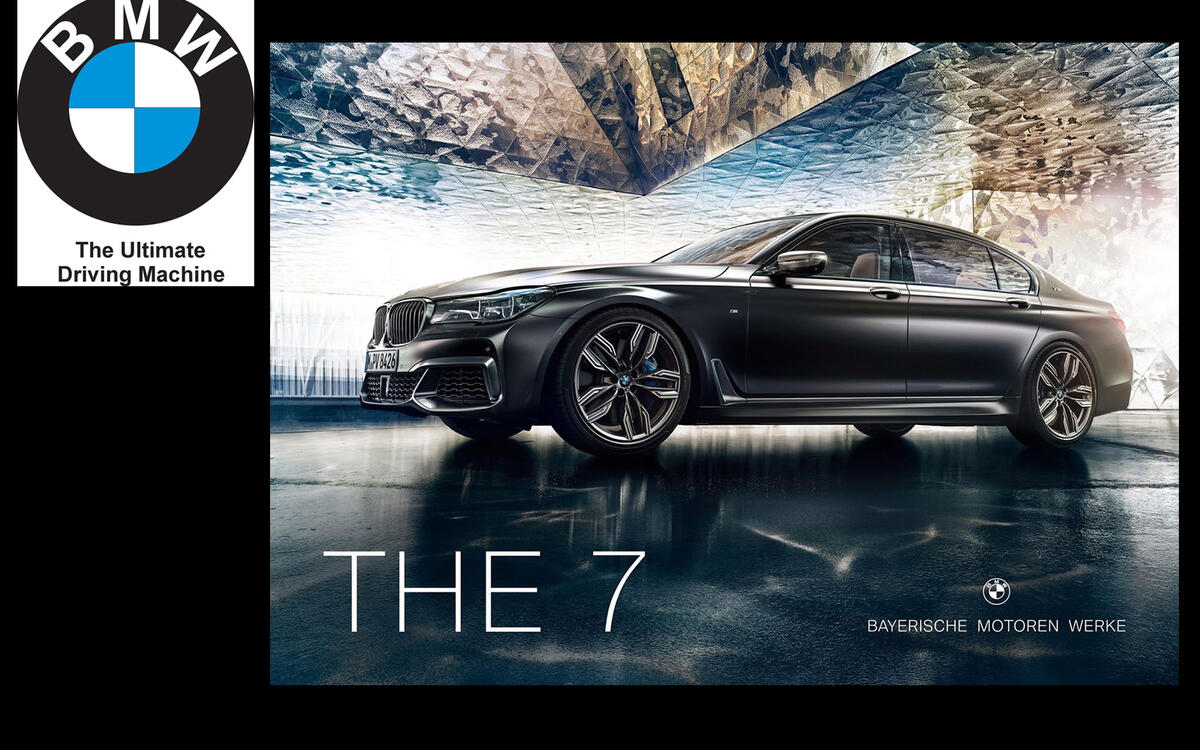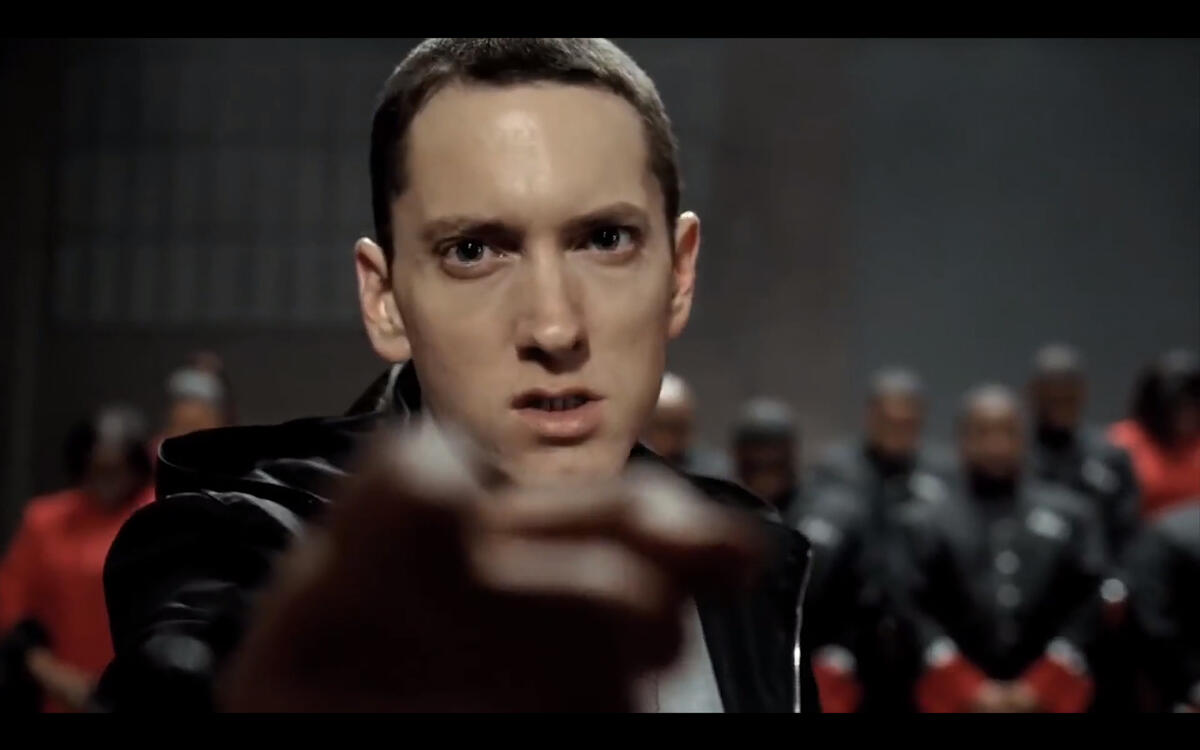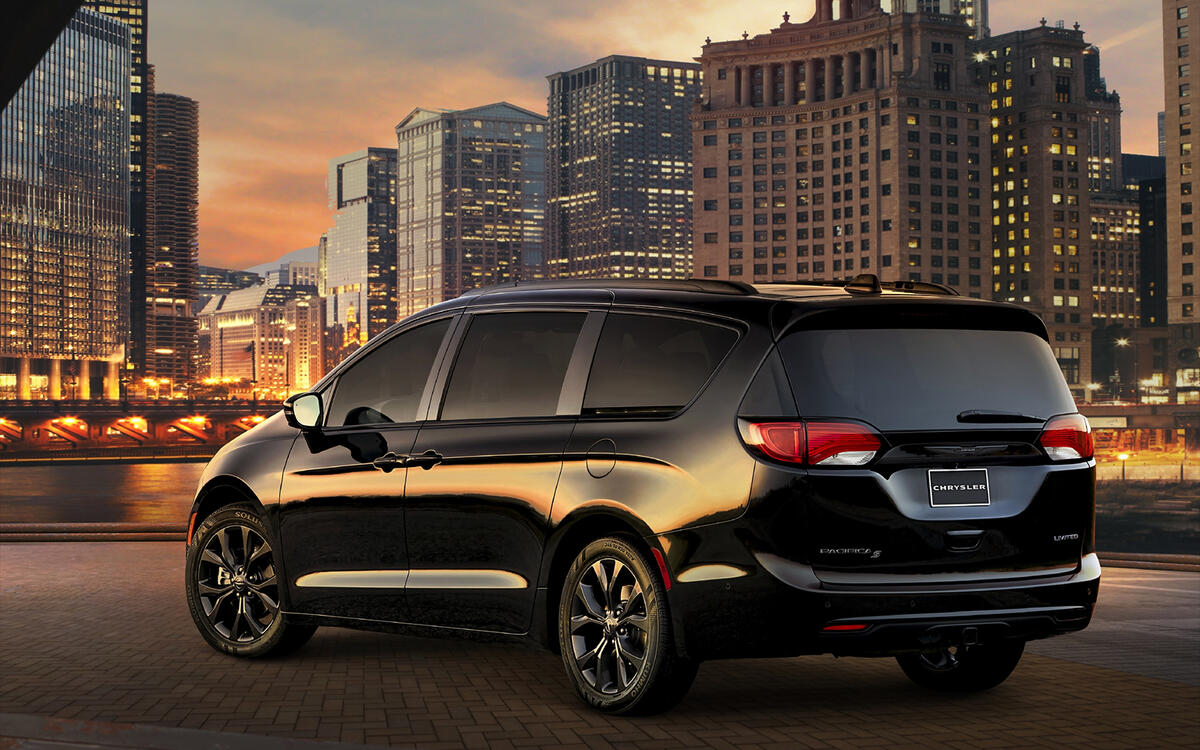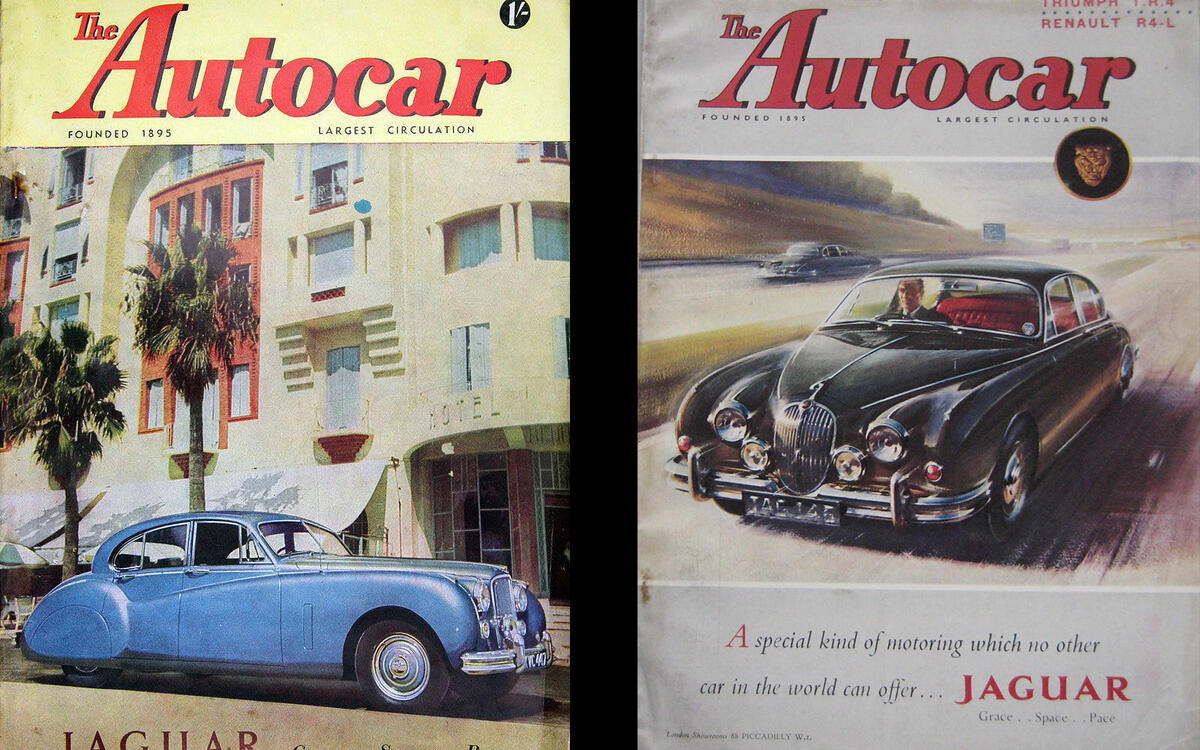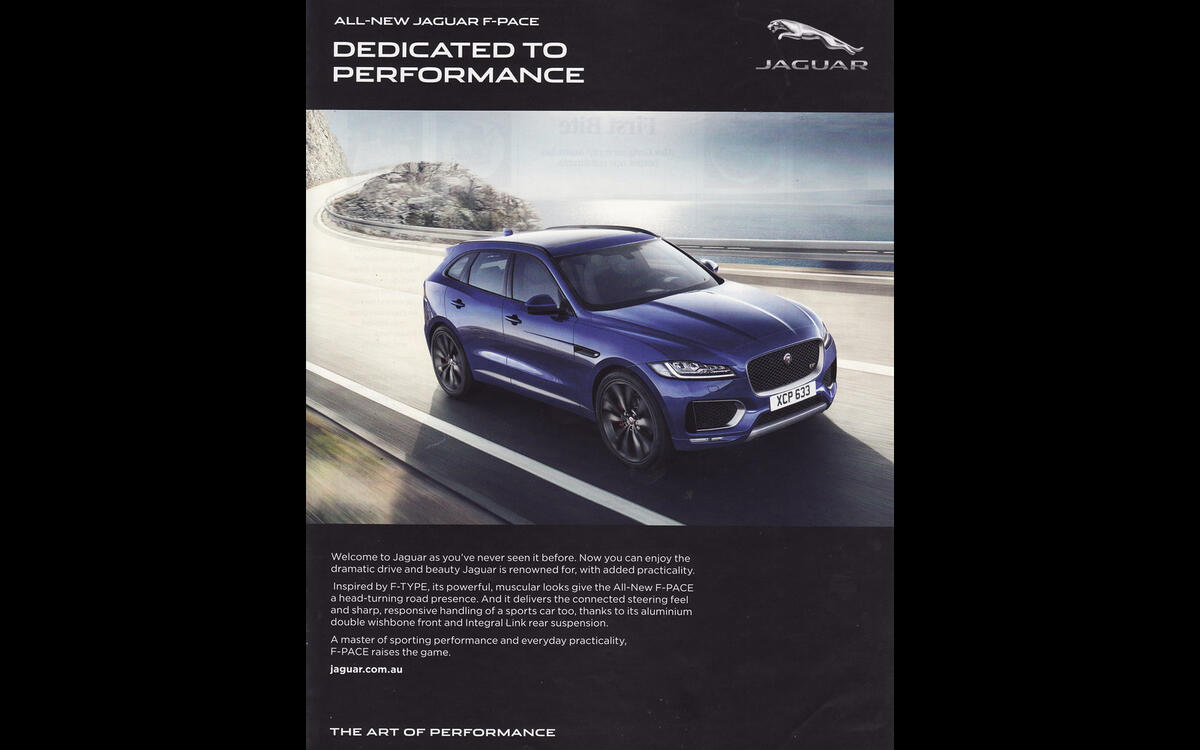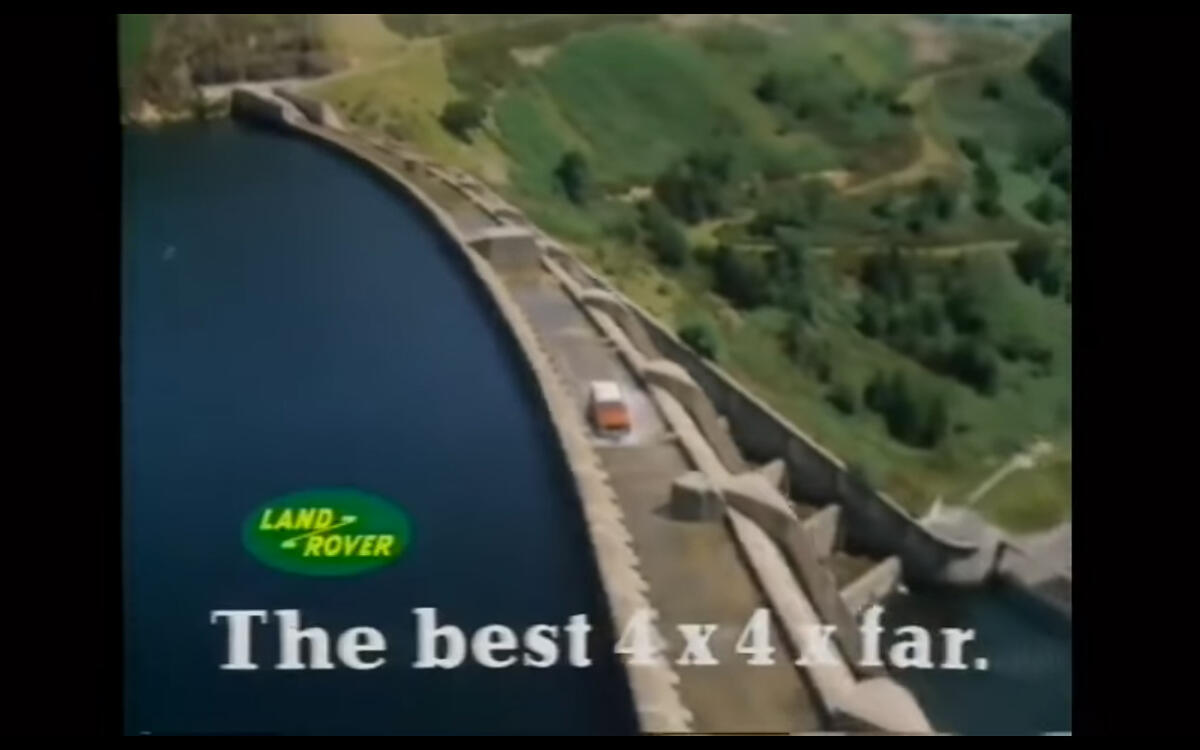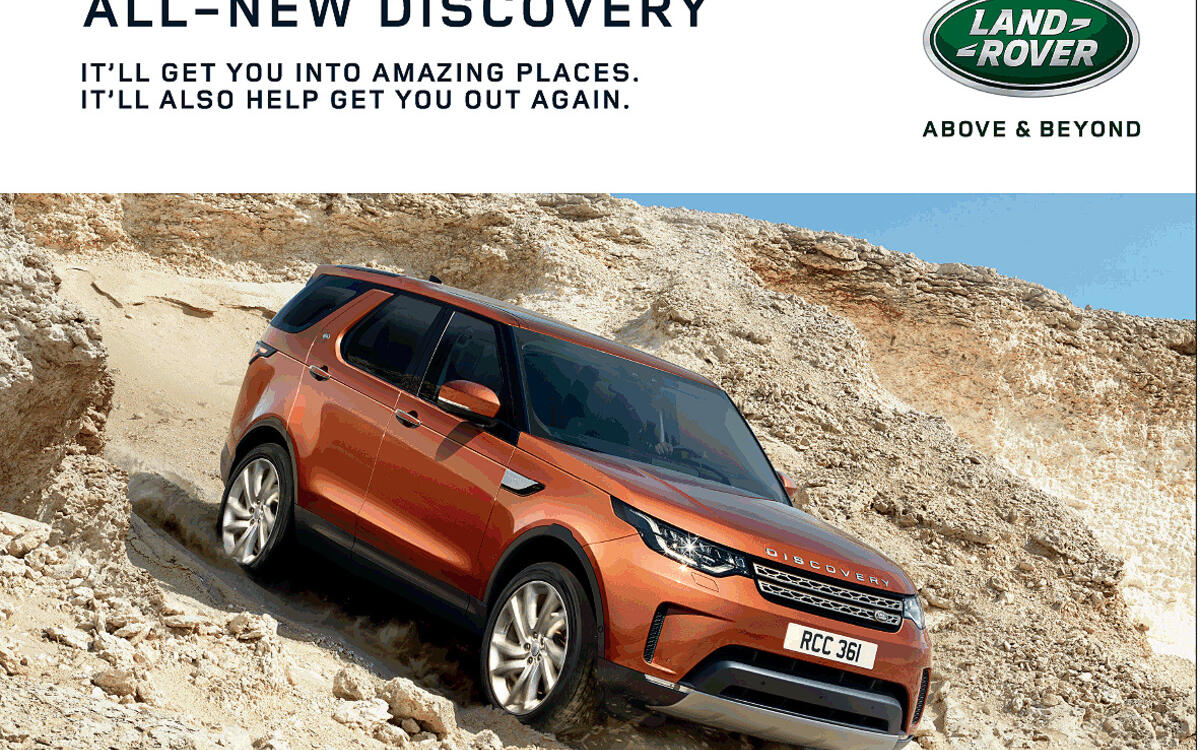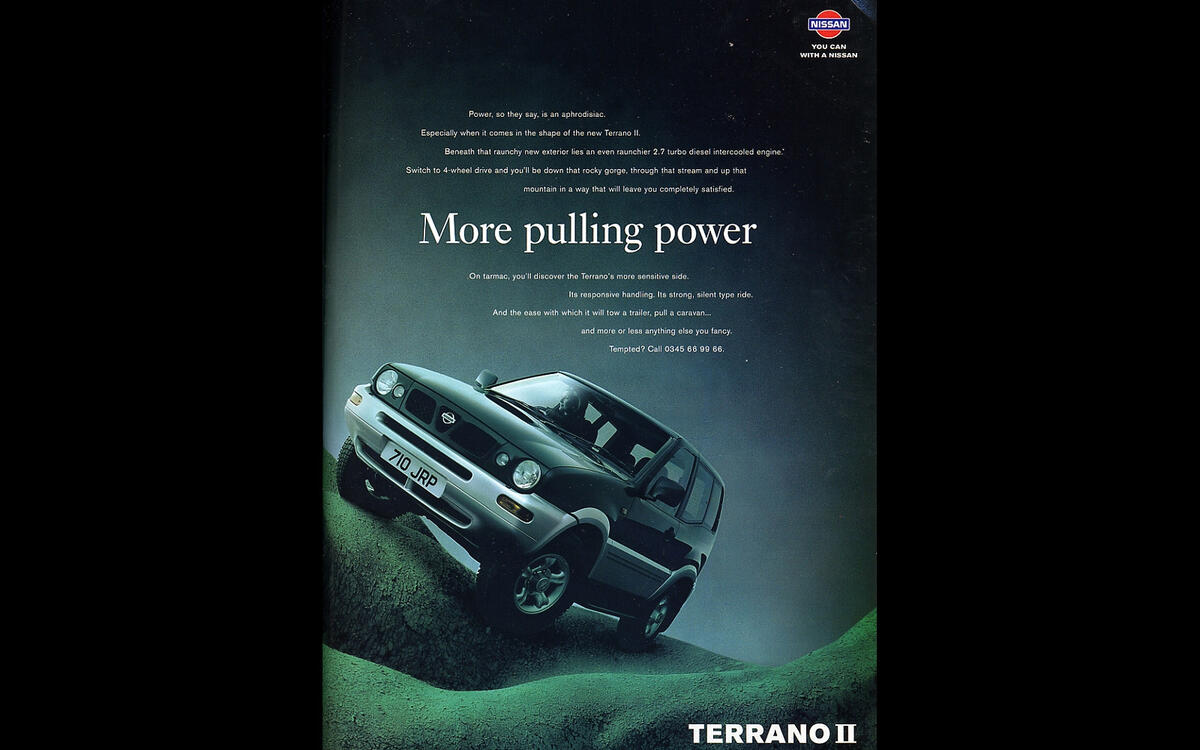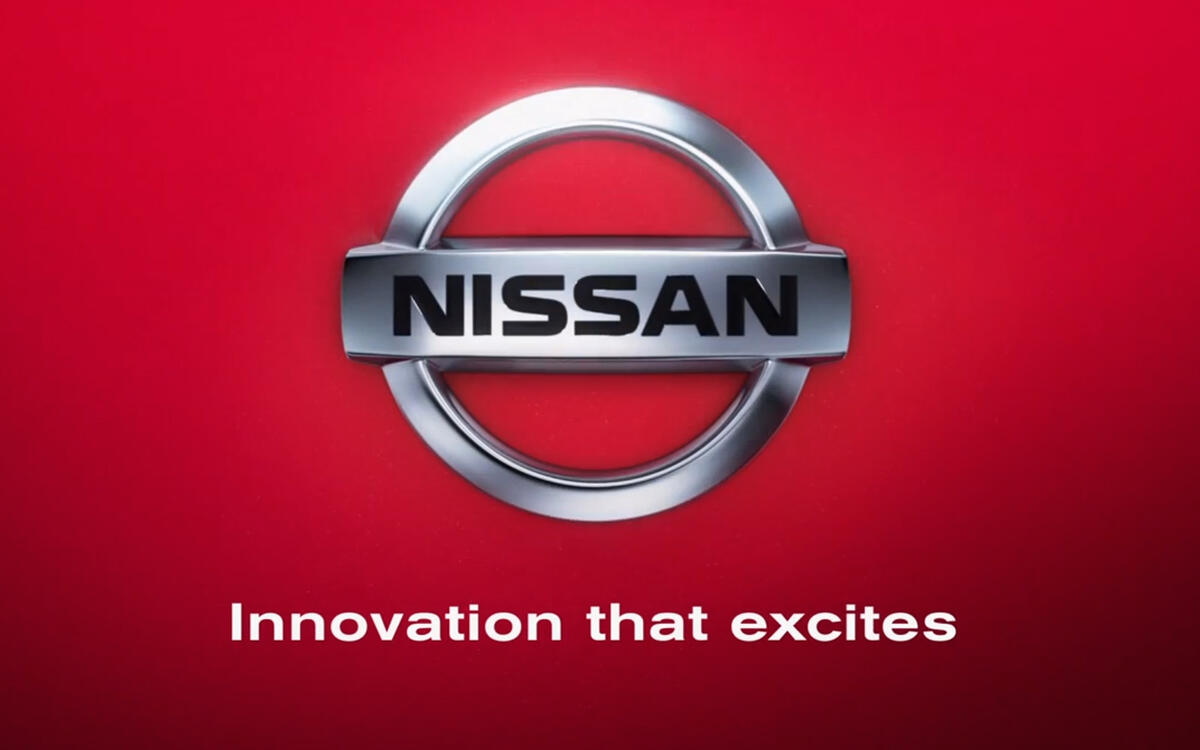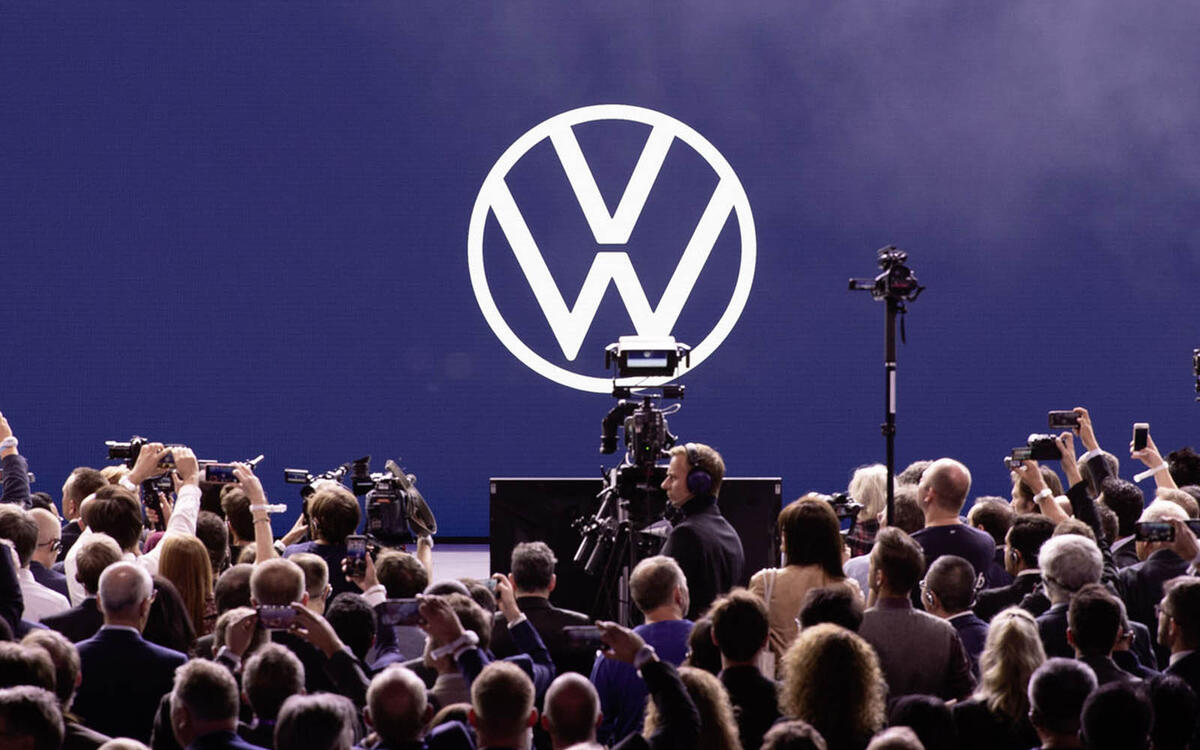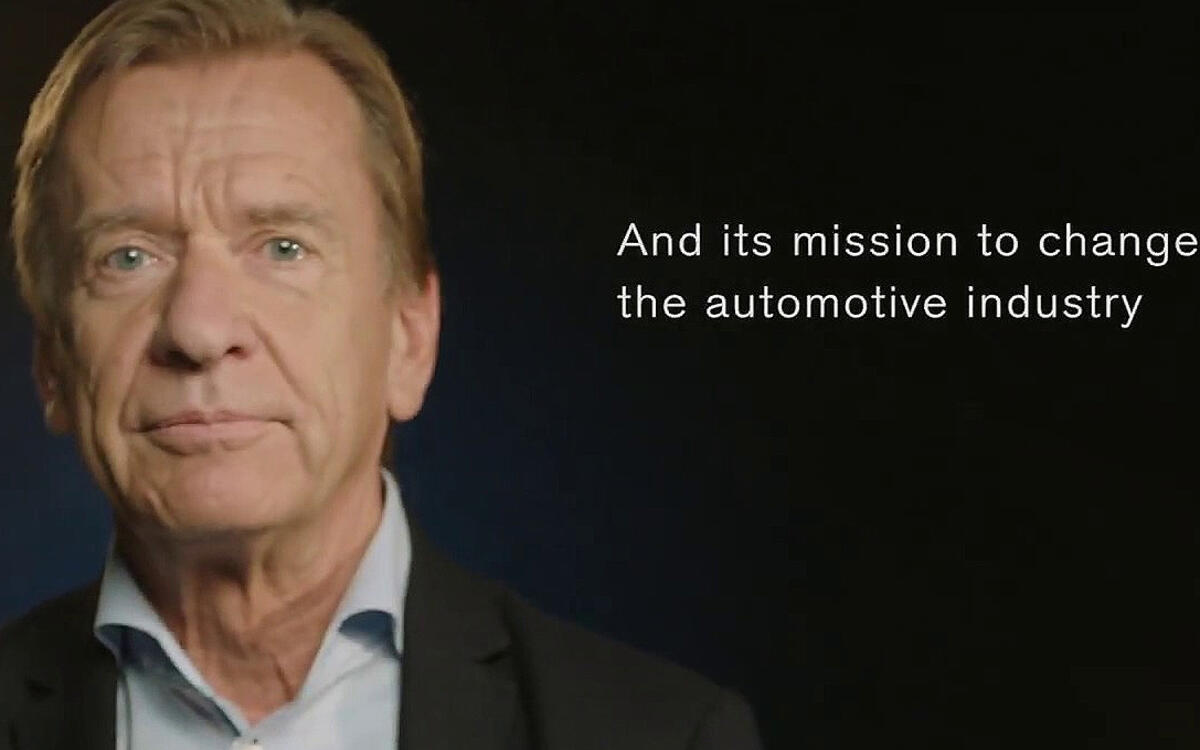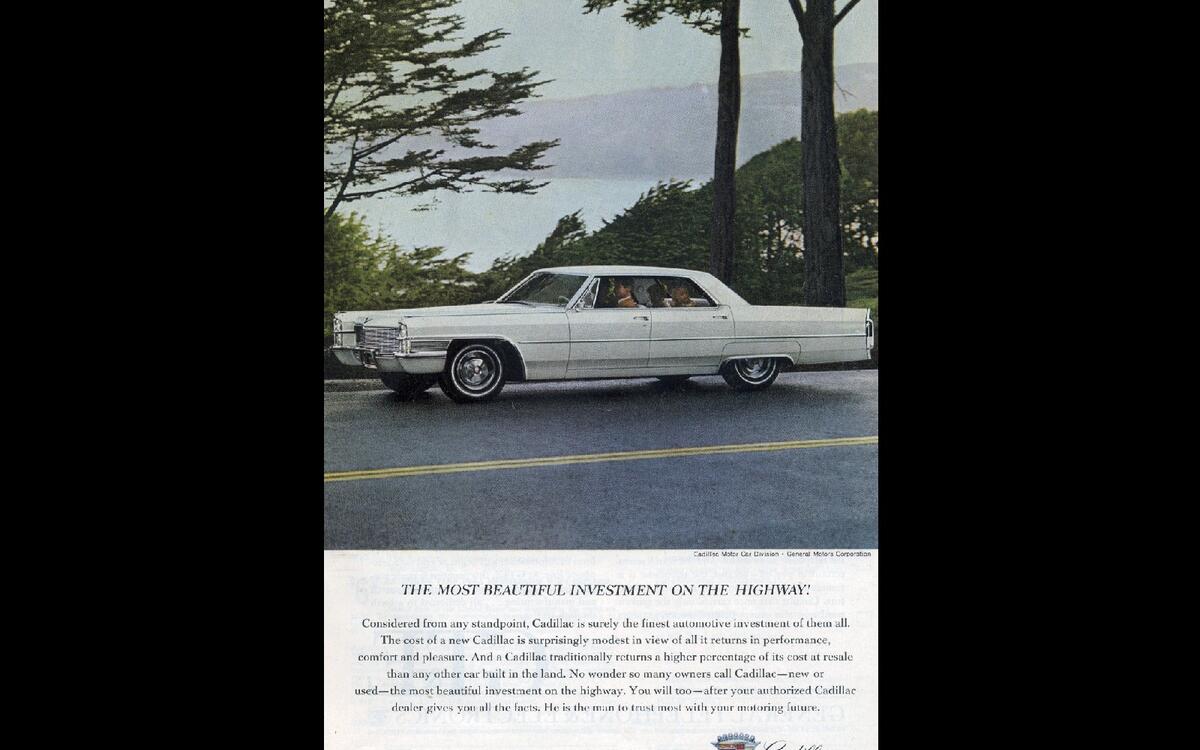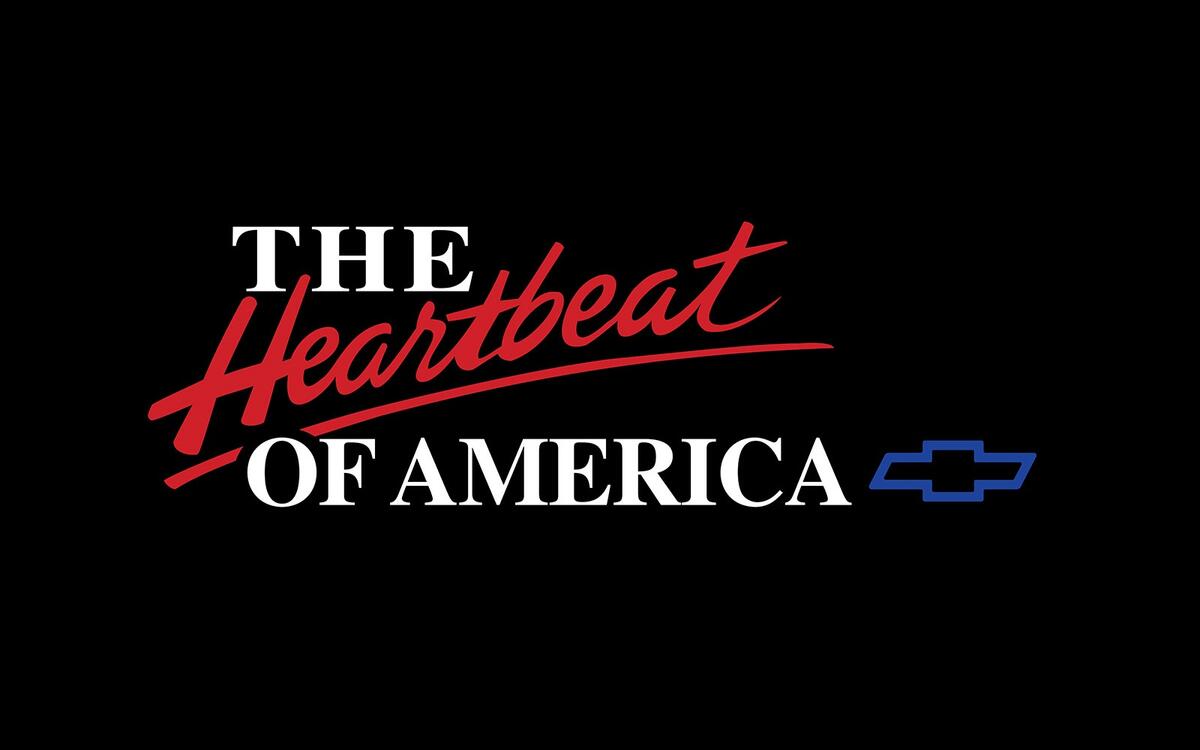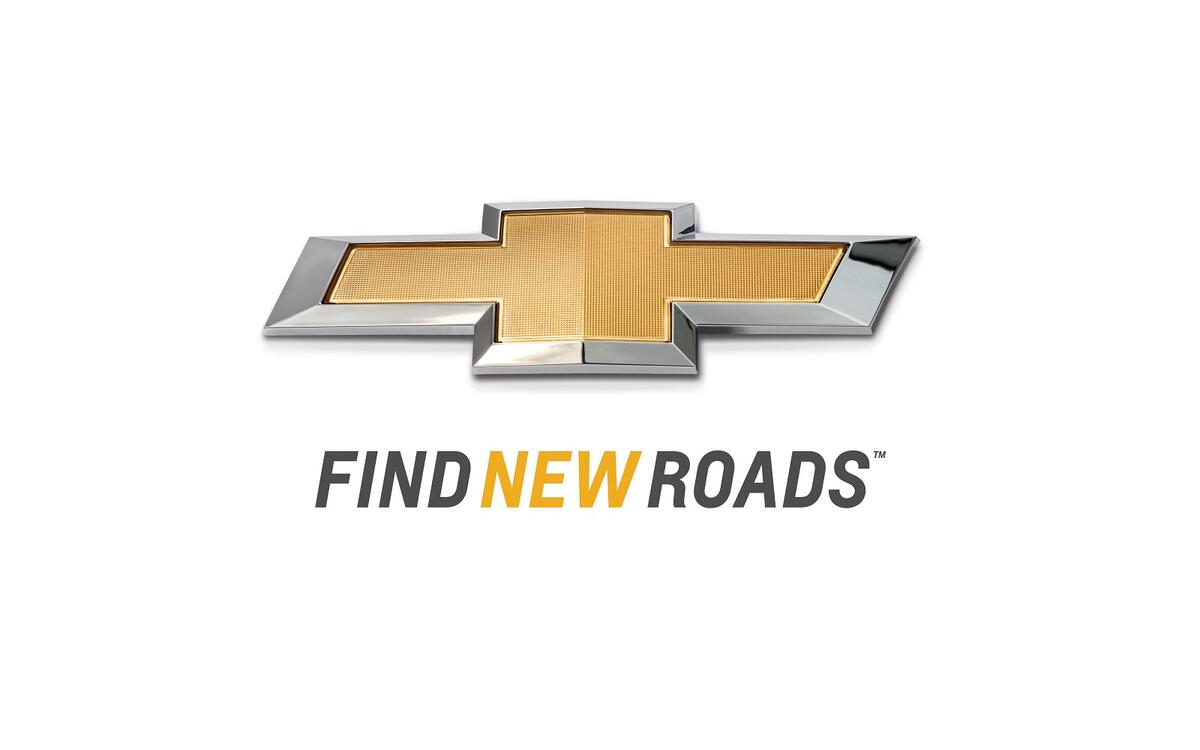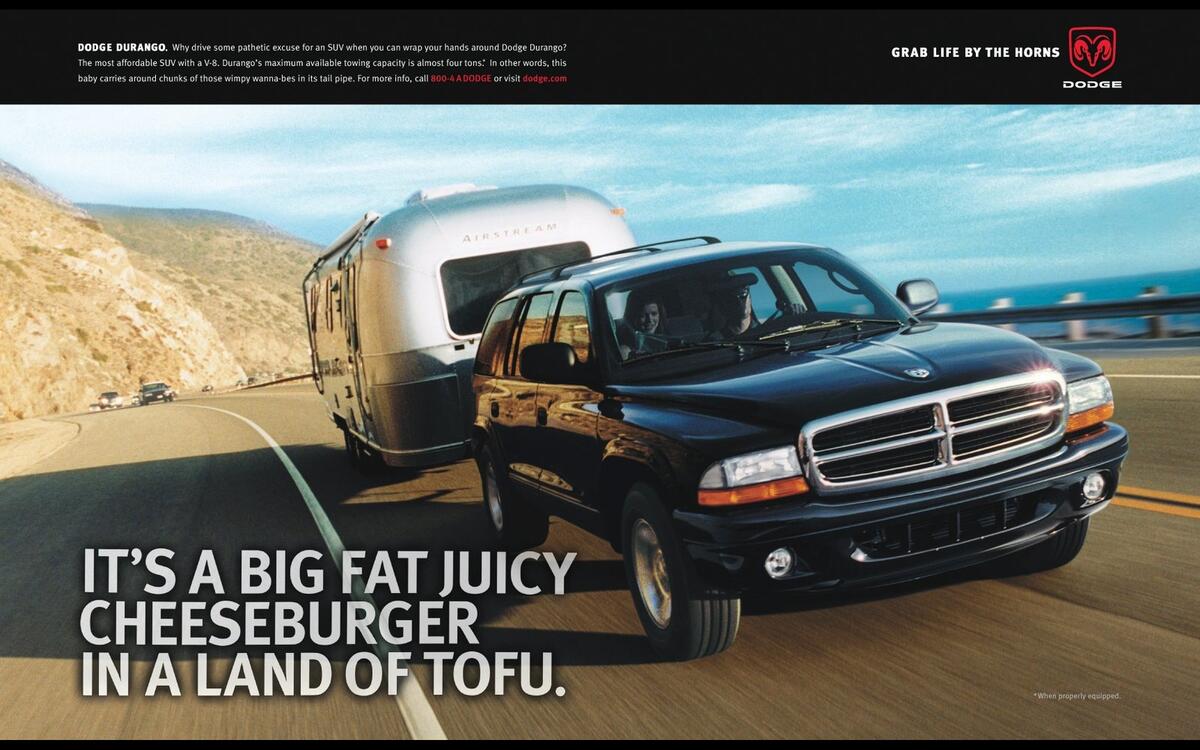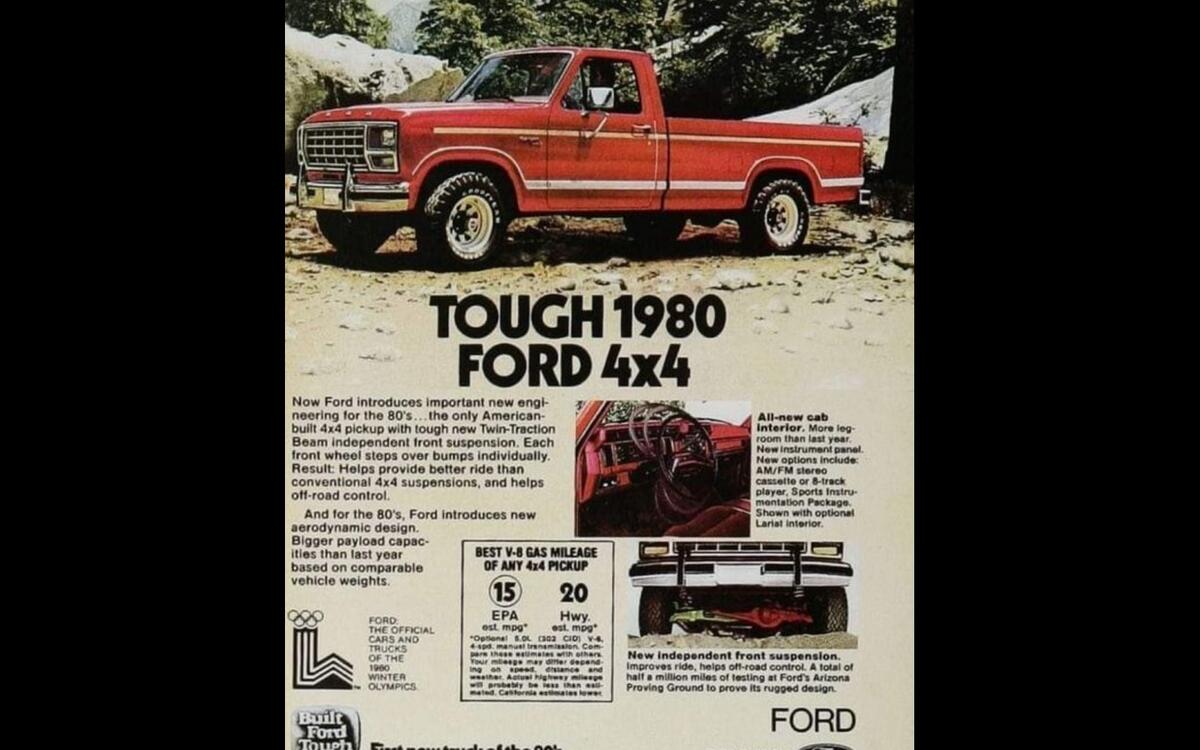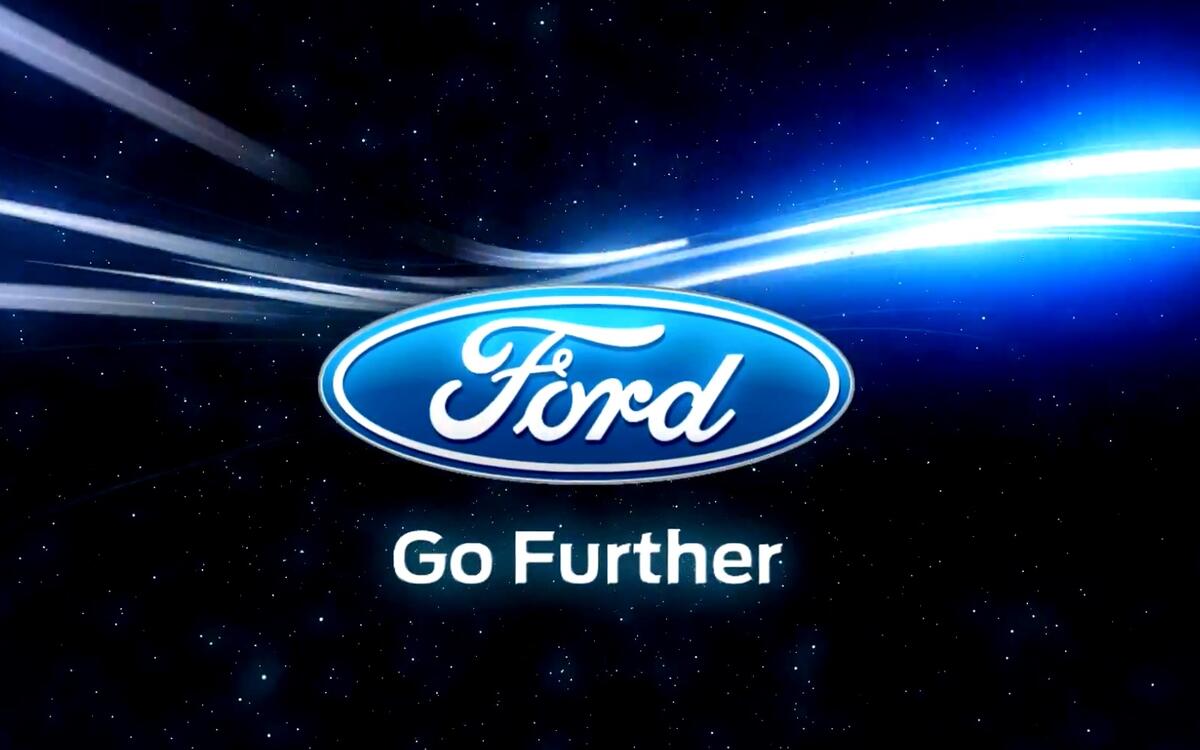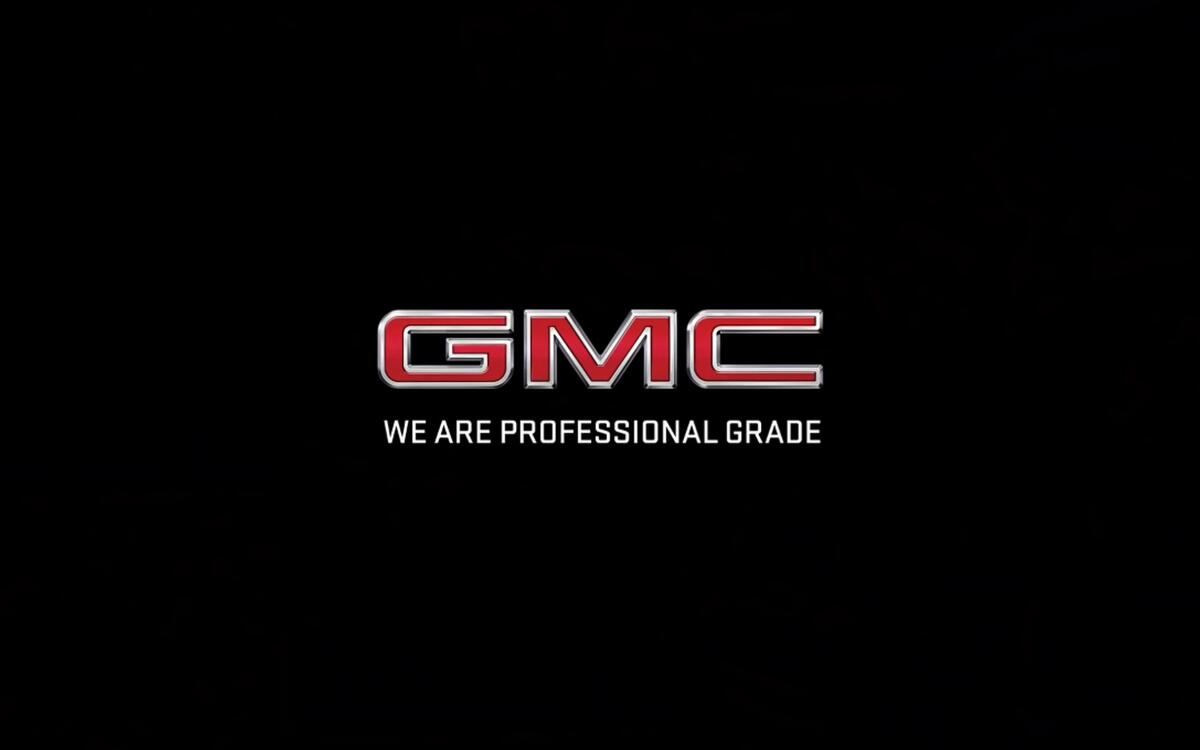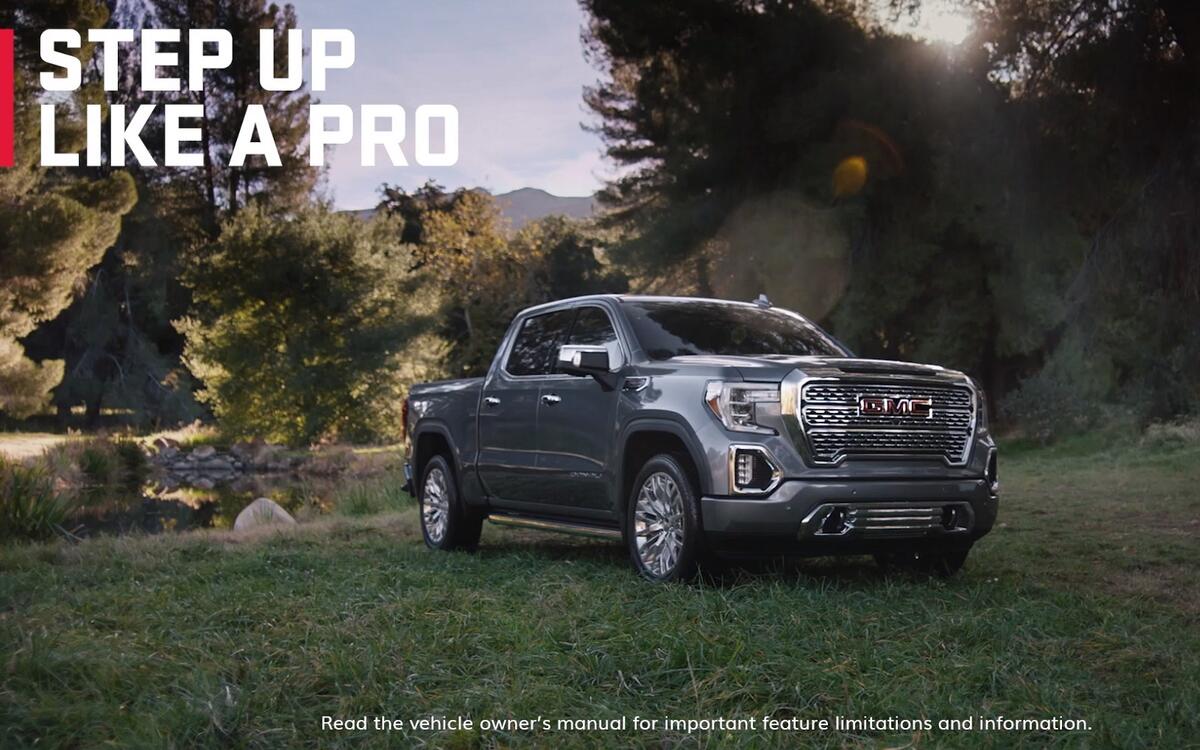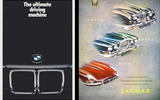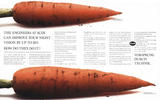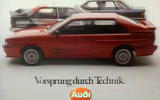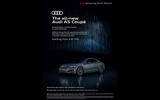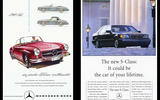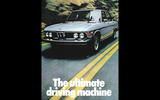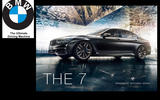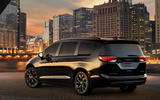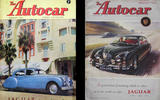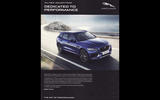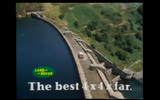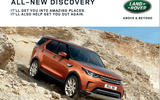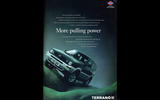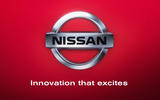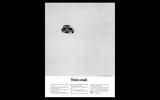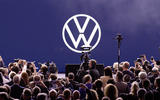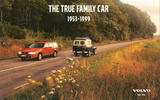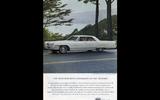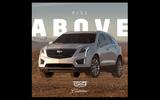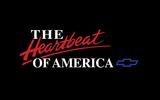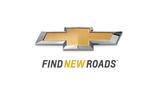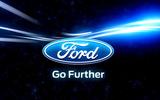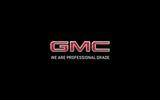 Slide of
Slide of
Nearly every car company that’s ever existed has had a defining slogan.
Some are so famous that they’ve become part of everyday language. Some were dreamed up in the distant past, and some are still in use. Time then to investigate the story behind the most famous slogans – and what that company uses today:
 Slide of
Slide of
Audi: Vorsprung durch Technik
In the early '80s, Audi was widely seen as a posh Volkswagen rather than a true rival to BMW and Mercedes-Benz. Exciting new cars like the Quattro started to change that, but its marketing needed a push. Newly-formed British ad agency Bartle Bogel Hegarty (BBH) was tasked with changing its image.
In 1982 BBH's creative boss John Hegarty toured Audi's Ingolstadt factory, seeking inspiration. He found it in a statement 'Vorsprung durch Technik' on a fading poster on the factory wall, an old internal-marketing message. It roughly means "advancement through technology" and conveyed in literal terms the qualities that British consumers had come to admire in German-built cars, at a time when most home-grown cars were famously poor.
 Slide of
Slide of
Audi: Vorsprung durch Technik
Hegarty later recalled "I had no idea that it would become that popular. It says everything and says nothing" but "it just captured people's imagination...Everyone looked at me as though I was mad [at first].” Seemingly breaking the cardinal rule of good communication - make the message literally understandable - it triumphed. Being voiced in TV commercials by the very British ‘retired Colonel’ sounding Geoffrey Palmer was another act of genius.
Mad or not, the phrase entered the language and the tagline ended up being used in many non-German speaking countries including much of Europe including the UK, France and Canada. It was later used in America, where it has often coexisted with its English equivalent, 'Innovation through technology.'
 Slide of
Slide of
Audi: Today
Helped by increasingly capable cars, today Audi is very much a member of the premium club it aspired to join 40 years ago. Recently, its fellow-Bavarian rival BMW paid it perhaps the, ahem, ultimate compliment, now using the line 'Bayerische Motoren Werke' in its English-language marketing. Audi is still using the slogan today alongside more recent confections such as 'For the epic or everyday' - which let's face it is not a patch on 'Vorsprung durch Technik.'
Audi trademarked its most famous slogan in 2010. Audi has also recently started using 'Vorsprung' as a high-end trim level for several of the firm's cars in European markets - these are fully-loaded derivatives and are a slightly cheaper alternative to ticking nearly every option box. There are few advertising slogans from 40 years ago in any field that are still in active use today, but 'Vorsprung durch Technik' seems to have become timeless.
 Slide of
Slide of
Mercedes-Benz: Engineered like no other car in the world
During the Second World War the factories of Daimler-Benz were heavily bombed, but by the mid-‘50s the company was getting back on its feet. And with the 190 SL and 300 SL, it had two glamorous models with which to mark the occasion. Not only did it have the cars, but it had a single slogan to cover the whole range for the first time as it eyed English-speaking export markets: 'Engineered like no other car in the world'.
The slogan would go on to be used for decades in most of the world, including the UK and America. It was simple, effective and frankly factual. At a time when overall car reliability was very low compared to the cars of today, Mercedes cars did seem to be made that much better and proved more dependable. So Mercedes left it unchanged until the ‘90s, where it was used to once again underscore the marketing message behind the 1992 S-Class W140 (right), arguably the most masterfully over-engineered Benz ever made.
 Slide of
Slide of
Mercedes-Benz: Today
During the mid 1990s the slogan that had served the company well was quietly dropped. Perhaps Mercedes thought that, after 40 years, it had had its day. Perhaps it also thought that, with the arrival of a fearsome new competitor from Japan, it was no longer strictly speaking correct: Less attractive and without the badge appeal of the Mercedes, the Lexus LS 400 of 1989 nonetheless featured amazing refinement, and bullet-proof reliability carried across from its parent Toyota. Indeed, it is said that it so startled Mercedes it delayed the W140 to make added refinements to head off the unexpected challenger.
Then, distracted by the Chrysler merger, the opening of production in the United States, and the conscious effort to remove the level of over-engineering in an average Mercedes, we saw the emergence of materials that seem to have been built to a budget, not a standard, which impacted the brand’s reputation for a time. The brand has largely recovered from that period now and is once again the leading German luxury car maker in terms of sales.
Its slogan today? Well, it mainly relies on the famous three-pointed star that’s been its logo for over 100 years, perhaps deeming it worth a thousand words.
 Slide of
Slide of
BMW: The Ultimate Driving Machine
In the early ‘70s Bob Lutz became head of sales and marketing for BMW; at the time it was very unusual for a German car company to have a foreigner - in this case an American - in such a senior role. But as BMW wanted to better establish itself in the American market, he proved an inspired choice. Disappointed with its underwhelming US slogan at the time - 'The Sportsman’s Car' - he wanted a better way to establish the brand in the minds of the US consumer, and worked with advertising agency Ammirati & Puris to decide on a new slogan to establish BMW cars as the keen driver’s choice.
'The Ultimate Driving Machine' was the result – it simply conveyed its message without ambiguity. But, crucially, at a time when many competitor cars were designed for comfort, BMWs largely delivered on the promise. The company started using the slogan in the United States in 1973, was widely adopted in other markets thereafter, and quickly became synonymous with the marque.
 Slide of
Slide of
BMW: Today
'The Ultimate Driving Machine' is still in use today, and is usually the first line you see when visiting an English-language BMW website. Indeed, this key slogan seems to have seen off internal rivals such as the controversial 'Joy' campaign (first used in 2009), where that word was used to create new short-lived slogans like 'Joy is timeless' and 'Joy was born for the left lane.' The new theme found few friends, and was dumped in 2012 in favour of 'Ultimate' again.
The line 'Sheer driving pleasure' in English and its German equivalent is also used today, along with certain model-specific slogans. Starting in 2018, as already noted BMW has also taken a leaf from Audi’s rulebook and began using the German language in English-speaking markets to emphasise, we presume, its German-ness. So its marketing often now includes its formal company name spelled out: 'Bayerische Motoren Werke.'
But we the think BMW’s original is still the best. If the success of an advertising slogan can be judged by its longevity, for 'The Ultimate Driving Machine' still to feel current and relevant when heading rapidly towards its 50th birthday is a great result.
 Slide of
Slide of
Chrysler: Imported from Detroit
It’s perhaps indicative of the mismanagement of the 94-year-old Chrysler brand that its most famous slogan dates back only to 2011, shortly after a period when the entire company nearly folded – and indeed probably would have done without help from Uncle Sam.
Nonetheless, 'Imported From Detroit' is an inspired line, implicitly playing on - and chiding - the fact that so many Americans today find troubled Motor City a foreign land, riven by crime and drugs, far away from its heyday as a driver of industrial prosperity and its vital ‘arsenal of democracy’ role during World War Two.
But the slogan was made real by a remarkable Emmy-winning two-minute TV commercial starring Detroit rap star Eminem (pictured) driving a new Detroit-built Chrysler 200, and first shown during the 2011 Superbowl. Produced by ad agency Wieden + Kennedy, it pulled few punches about the recent plight of both Chrysler and its birthplace, keyed along by the Eminem track ‘Born of Fire’, suitably enough. And it struck a note of dogged determination, underlined by Eminem himself at the very end: "This is the motor city, and this is what we do."
 Slide of
Slide of
Chrysler: Today
After that amazing commercial, everyone immediately went out and bought a Chrysler 200 and never even thought about buying a BMW 320i ever again, and everyone lived happily ever after. Sorry… but no. The car market is a hard, unromantic place and not a Hollywood movie; no single commercial could ever save the hide of a car as mediocre as the 200 nor a brand as long neglected as Chrysler.
In 2016 company Fiat Chrysler CEO Sergio Marchionne said that the 200 and its sister car Dodge Dart were “the least financially rewarding enterprises that we’ve ever carried out.” It was axed later that year, and Chrysler today is down to just two effective models in the US: the Pacifica (pictured) and Voyager minivan twins and the 300, a saloon that had a brief cult status at launch in 2004 but is now just plain old. Often seen as a throwback to Chrysler’s ‘80s glorydays, the MPVs ironically are partly being kept in business by a force from the future: a deal with Google’s Waymo to use them as large-scale test cars for autonomous vehicles.
And the 'Imported From Detroit' line no longer works, for all Chryslers sold in the US are today made in Canada. Chrysler was once a great innovator – it gave us the first production cars anywhere to feature disc brakes, electric windows and power steering, among much else. But today it’s overshadowed by its successful progeny, Jeep and Ram, and, truth be told, we’re not quite sure what Chrysler stands for in 2019, and nor we fear does Chrysler.
 Slide of
Slide of
Jaguar: Grace, space, pace
Whisper this quietly, but these famous words were first used by MG to promote its SA and WA saloons in the 1930s, albeit as 'Space, grace, pace.' Then, after the war, Jaguar founder William Lyons re-ordered them himself to promote the launch of its Mk5 saloon, and the rest is history. It is surely one of the best automotive slogans of them all, as it rhymes, rolls off the tongue easily, and communicates in a succinct fashion key Jaguar tenets. And tenets that most Jaguars mostly exuded in spades, for decades.
The slogan was dropped at the end of the 1960s when Jaguar was subsumed into the dysfunctional blob that was British Leyland (BL), ushering in a dark period for the company and indeed the entire British-owned motor industry. And yes, back in those days we featured advertising on our front page, as was common to the magazines of the time.
 Slide of
Slide of
Jaguar: Today
William Lyons lived just long enough to see Jaguar emerge from the BL blob and regain its independence in 1984, though not long enough to see it subsumed into Ford in 1989. Jaguar no longer officially uses the 'Grace, space, pace' line but the company did pay it a huge accolade by deriving the name of its new SUV range from it, thus we have the F-Pace, smaller E-Pace, and all-electric I-Pace.
Announcing the F-Pace in 2015, design chief Ian Callum admitted that while Jaguars always had style and speed, they didn’t always have space – something he aimed to put right with the brand’s first crossover. Jaguar’s major slogan today is 'The Art of Performance', which is fine in an airy kind of way, but not a patch on that line from the ‘50s. With thanks to Graham Searle at the Jaguar Enthusiasts' Club
 Slide of
Slide of
Land Rover: The best 4 x 4 x far
Land Rover has always promoted its ability to go anywhere and do anything. In its early years it used slogans such as 'The go anywhere vehicle', 'Britain’s most versatile vehicle', and 'No ground too rough, no job too tough'. But in 1986, the company moved up a gear and launched an extraordinary TV commercial featuring a Land Rover apparently winching itself up a near vertical 236-foot high dam - Clywedog in central Wales - accompanied by the stirring music from the classic war movie ‘The Dambusters’ and voiceover from Patrick Stewart AKA ‘Captain Jean-Luc Picard’. ‘The best 4 x 4 by far’, indeed.
Nearly 30 years later Richard Hammond on the BBC’s Top Gear successfully recreated the ad – this time at the dam at Claerwen, also in Wales – but using the vehicle’s own power, albeit by using an auxiliary engine at the back; the motor in the front would have stopped working at such a steep angle. It’s said that the original commercial had actually used a huge winch at the top, the invisibility on screen of which Hammond artfully describes as the ‘magic of television.’
 Slide of
Slide of
Land Rover: Today
Like all the best slogans in this feature, 'The best 4x4 by far' is still used on occasion in the company’s advertising and in executive presentations. But the company’s primary slogan today is 'Above & Beyond', which is nice as far as it goes but we still prefer the its most famous line, a work of singular genius.
Land Rover had very few direct competitors in 1986; now virtually every car company in the world, from Dacia to Rolls-Royce, makes a 4x4 in one shape or another. In a nod to its most famous slogan, the company will be hosting the 4xFAR music and adventure festival in Coachella Valley, California, in January 2020 to celebrate the launch of the new Defender.
 Slide of
Slide of
Nissan: You can with a Nissan
Nissans for a long period were sold under the Datsun name in most major markets, with the parent Nissan brand being gradually introduced as a sub-brand during the 1970s. The Datsun brand was replaced by Nissan in the UK and the US in 1984. But in car company terms, it was a ‘new’ brand, which needed establishing.
So – far from alone in this story – Nissan’s UK advertising agency played with words and coined the rhyming phrase 'You can with a Nissan'. And when used to promote an offroader like the Terrano II as pictured, it kind of works. In America, the company went with the slightly less catchy 'The name is Nissan.' Its hardier and performance vehicles were also promoted there under the 'Built for the Human Race' line, which was clever.
 Slide of
Slide of
Nissan: Today
In our current era of ‘lifestyle marketing’ it’s no great surprise to see that Nissan’s most famous line has been buried deep in the advertising scrapheap. In the UK and the USA today the company’s slogan is 'Innovation that excites' which while reflective of our tech-driven age also strikes us very much as something of a slogan decided by a committee.
 Slide of
Slide of
Volkswagen: Think Small
In the 1950s, Volkswagen wanted to expand into America, but it had a problem. Its Beetle was a very small car compared to the huge barges being churned out by Detroit that dominated the market at the time. So instead of being embarrassed about it, it went loud and proud instead, expressing the simple virtues of a small car. The 'Think Small' slogan was devised by copywriter Julian Konig (1921-2014) at VW’s US ad agency Doyle Dane Bernbach (DDB) in 1959.
Advertisements for the campaign were filled mostly with white space, emphasizing the vehicle’s size, while text underneath emphasised the virtues of ‘small’ including ease-of-parking, fuel economy, small insurance and repair bills. The campaign was very successful; by the late ‘60s, VW was selling over 400,000 Beetles per year in America. The campaign was ranked the best advertising campaign of the century by marketing industry journal Advertising Age in 1999.
 Slide of
Slide of
Volkswagen: Today
In common with other German carmakers, VW has long benefitted from the positive associations most car buyers nearly everywhere hold for German cars in terms of their status, reliability, performance and engineering standards. Thus like some of the German makers already mentioned the brand in the 21st century emphasised this, using the slogan 'Das Auto' in many English speaking markets including the UK and US with a campaign that started in 2008.
It literally means 'The Car' and was deemed successful for a while. That is, until 2015 and the dieselgate scandal enveloped the company and caused enormous damage to its reputation. At this point the slogan’s somewhat imperial inclinations took on a faintly sinister air, prompting it be dropped just three months after the crisis first broke. Today, Volkswagen’s slogan underneath its logo is, well, 'Volkswagen', and at the 2019 Frankfurt motor show recently it unveiled a new, simplified logo and brand identity to try and turn a new leaf (pictured).
 Slide of
Slide of
Volvo: For Life
This stunningly simple and clever Volvo Cars slogan was first used by the Swedish brand in 1999, shortly after Ford bought the company. Its genius is that the slogan allowed Volvo to emphasise its cars’ focus on safety, their durability, their ability to fit into their owners’ lives, the fact you’ll never buy another brand (in theory), even their environmental credentials – all in just two simple words: 'For Life'.
During Ford’s 11 years of ownership the company expanded its model range and in 2002 launched a notably successful large SUV, the XC90. And while Volvo didn’t quite join the premium classes it hoped, it did a lot better than GM’s ownership of its Swedish rival Saab, which wound up dead.
 Slide of
Slide of
Volvo: Today
'For Life' continued to be the main slogan for Volvo Cars for nearly two decades, even after the company came under the ownership of China’s Geely in 2010. The new parent company funded a rejuvenation and expansion of the company’s model range, whose quality finally made it a true player among Volvo’s primarily German premium car rivals.
Accordingly, Volvo’s unveiled a new slogan and company mission statement in 2018: 'Freedom to Move'. “Freedom to move… is really the beauty of a car,” said Volvo’s CEO Håkan Samuelsson (pictured) in 2018. “You can move wherever you want, whenever you want, but it has, of course, to be in a sustainable, personal and safe way.”
 Slide of
Slide of
Cadillac: The Standard of the World
Ironically perhaps considering it’s never been a player in the UK, Cadillac’s best-known slogan traces its roots to events in Britain over 100 years ago. In 1908, the Royal Automobile Club awarded its prestigious Dewar Trophy to the American firm to recognize the high degree of standardisation in its manufacturing process. Three identical, randomly-selected Cadillac Model Ks were driven about 25 miles to the Brooklands track and lapped it 10 times. They were then completely disassembled. Their parts were mixed and 89 components provided by a local dealer were thrown into the blend before the cars were reassembled and driven at top speed for 500 miles.
This feat was spectacular; it showed what Cadillac was capable of in terms of engineering and manufacturing. The firm called itself 'The standard of the world' and the new slogan appeared in print ads for decades. When standardisation became the norm rather than the exception, its meaning was changed to denote elegance, luxury and power. It represented an era when Cadillacs were palaces on wheels characterised by power everything, an imposing design and a big V8.
 Slide of
Slide of
Cadillac: Today
Cadillac can’t credibly call itself the standard of the world in 2019. Whether its cars could live up to that claim is irrelevant to this argument because they’re absent from so many global markets. The General Motors-owned firm invests time, energy and money into competing in the United States and China. Audi, Jaguar and Lexus don’t perceive Cadillac as a threat on their respective home turfs.
And yet, the 'Rise Above' tagline it introduced in 2019 loosely references the era in which it proudly promoted itself as 'The Standard of the World'. It quietly acknowledges Cadillac lost its focus, customers and its image as it tried to be everything to everyone during the 2000s. The cars in its range were often competent but incongruent. In the late 2010s, it decided to return to its roots and put an American spin on luxury. For the company, 'Rise Above' references overcoming obstacles and, on a secondary level, passing its rivals to once again make cars that global buyers aspire to see in their garage.
For buyers, it’s an aspirational slogan that encourages them to work hard, beat life’s challenges and earn enough money to buy a nice car. An ad using the 'Rise Above' tagline shown during the 2019 Oscars highlighted the company’s SUV range so it might mean stepping up – quite literally.
 Slide of
Slide of
Chevrolet: The Heartbeat of America
By marketing its cars as 'The Heartbeat of America', Chevrolet signalled the vehicles it built were more than the sum of their parts. The slogan was introduced in 1985, as Chevrolet – like all of its American rivals – watched its market share erode as buyers increasingly turned towards Japanese cars.
The 'Heartbeat of America' aimed to show that Chevrolet’s cars were woven into the country’s fabric. Its trucks worked on farms, its vans delivered goods from coast to coast, and its passenger cars took kids to school. It had a tinge of nostalgia and a trace of friendly patriotism. Television ads promoting the slogan featured a catchy jingle that helped cement Chevrolet’s message in the minds of car buyers.
 Slide of
Slide of
Chevrolet: Today
Chevrolet replaced its 'Chevy Runs Deep' slogan with 'Find New Roads' in 2013. It needed to reinvent its image after parent company General Motors (GM) filed for bankruptcy in 2009 and it wanted the new slogan to emphasise novelty. The underlying message was that Chevrolet had learned, evolved and changed.
Still used in 2019, 'Find New Roads' is strikingly similar to Ford’s 'Go Further' slogan and comparably vague. It leaves a lot to the consumer’s imagination by evoking adventure without creating it. While almost all Americans were familiar with Chevrolet’s 'The Heartbeat of America' slogan, 'Find New Roads' isn’t as well known, though that might be because motorists are far less exposed to magazines, television shows and radio stations than in the past. You don’t see Chevy ads on Netflix; getting a slogan to stick is more difficult as 2020 approaches than it was in the 1980s.
 Slide of
Slide of
Dodge: Grab Life by the Horns
Dodge didn’t invent the phrase "Grab life by the horns" but it appropriated it in 2001. It was a no-brainer; its logo was a ram with a pair of massive horns and the phrase’s original meaning (essentially “take control of your life”) backed up the bold, fearless image it was trying to give itself. The slogan argued those who drove a Dodge were more daring and led more exciting lives than motorists who settled for commuting in blander-looking cars.
We can’t help but wonder if the firm’s marketing team had Toyota, whose cars had become a byword for boring by the early 2000s, in mind. 'Grab Life by the Horns' stuck because many Americans already knew the phrase. It was a little long for an advertising slogan so Dodge shortened it to 'Grab Life' in 2007.
 Slide of
Slide of
Ford: Built Ford Tough
The 'Built Ford Tough' slogan made its debut during the 1979 model year in America. It arrived as Ford prepared to close a tumultuous decade marred by recurrent oil crises and looked forward to the 1980s. The highly profitable F-Series became America’s best-selling pickup in 1977 and the slogan was envisioned as a way to keep the momentum going while building on earlier taglines that also emphasised toughness. It implied the company had higher durability standards than Chevrolet and Dodge, its main rivals. It was remarkably effective, partly because it was short, easy to remember and it conveyed a simple message.
'Built Ford Tough' resonated with pick-up truck buyers, who were already the most loyal group of motorists in the United States. Used for decades, the slogan appeared on license plate frames, t-shirts, hats and much else. Dealers adopted it, too, and it’s still often seen in 2019. 'Built Ford Proud' is also used.
 Slide of
Slide of
Ford: Today
Ford rolled out its current global 'Go Further' slogan in 2012 after recovering from a near-death experience in 2009. 'Go Further' differed from the firm’s previous slogans because it was coined to speak as much to employees as to consumers. The underlying message, according to executives, was that Ford nearly got consigned to the automotive attic after riding through a period of complacency the entire corporate structure got blamed for. The slogan was adopted to remind interns, board members, and everyone in between to go the extra mile and ensure Ford remains healthy and profitable.
This approach makes sense if you’re on Ford’s payroll, but it’s more difficult to grasp if you’re in the market for a new car. Go further on a tank of fuel? Go further into the wilderness with a new SUV? It can mean either or both of these things or something else entirely but it has no clear, well-outlined definition and the connection with Ford’s cars is opaque at best.
 Slide of
Slide of
GMC: We Are Professional Grade
Historically in America, precious little has differentiated GMC’s trucks and SUVs from those manufactured by sister company Chevrolet yet they’ve generally come with a higher price tag. The brand tried justifying this positioning in 2000 when it launched the 'We Are Professional Grade' slogan that implied its vehicles were better suited to handle the grueling demands of construction sites than Chevrolet’s.
An aura of dubiosity always surrounded this slogan. It largely applied to pickup trucks because there was nothing professional about a family-friendly, leather-upholstered SUV like the Envoy. And, the automaker offered no tangible evidence when asked what made a Sierra more professional than a Silverado. It worked, though: GMC’s uncanny ability to charge a premium for its models kept it off the chopping block when parent company General Motors trimmed its portfolio of brands during the 2000s, losing Oldsmobile, Pontiac, Hummer and Saturn.
 Slide of
Slide of
GMC: Today
GMC began replacing 'We Are Professional Grade' with 'Like a Pro' in 2017. The basic meaning is the same and it echoes the 'Like a Rock' slogan Chevrolet used during the 1990s. It’s more credible in 2019 than its predecessor ever was, however. While the Sierra remains identical to the Silverado under the sheet metal, GMC has taken big steps to differentiate the two models through design and equipment.
It’s notably available with a six-way tailgate named MultiPro and a highly durable cargo box insert made with carbonfibre, two features that don’t appear on Chevrolet’s list of options.
Feature by Tom Evans and Ronan Glon
Grace, space and pace – and many more: time to investigate the story behind the most famous automotive slogans
Advertisement



